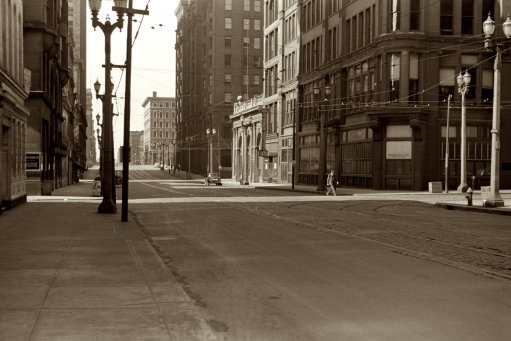On the Road: Indianapolis, Indiana
Click on Thumbnail for MapUnfolding the Map
Back across the heartland goes Sal, making out as he makes his way to Indianapolis. Click on the map to travel with him.
Book Quote
"The bus roared through Indiana cornfields that night; the moon illuminated the ghostly gathered husks; it was almost Halloween. I made the acquaintance of a girl and we necked all the way to Indianapolis. She was nearsighted. When we got off to eat I had to lead her by the hand to the lunch counter. She bought my meals; my sandwiches were all gone. In exchange I told her long stories."
 LS Ayres Department Store lunch crowd in 1940s Indianapolis
LS Ayres Department Store lunch crowd in 1940s Indianapolis
Indianapolis, Indiana
I've never been one to take the straightest and quickest route to where I'm going unless I absolutely have to be someplace and I only have a certain amount of time to get there. Nor do I like taking routes around cities, the loops that allow motorists to avoid the downtowns and their traffic just like one might take a circular path around a person one doesn't really wish to see at a party or gathering. So, while on a road trip one day approaching Indianapolis from the east and faced with the choice of taking I-465, the loop around to the north of the city that eventually joins with I-65 on the northwest, and shaving a few minutes off my trip back to Milwaukee, or heading into downtown Indianapolis, I aimed my bumper straight toward the downtown and didn't look back. After all, I'd never seen Indianapolis.
I find the interstates to be another manifestation of our "Bowling Alone" syndrome in the United States. Where once motorists, pre-interstate system, had no choice but to brave the unknowns of a city or town because the road would take them right through the center of it, now we have interstates looping us around towns and cities and even when we go through, we zip past at 55-65 miles per hour and barely register what we see. We miss all the businesses flashing their products and services and are unhindered by stoplights making us take a moment to see place and surroundings. We might get into a traffic jam that slows us down, but then our glimpse of where we are is spoiled by our anger and frustration at not being able to get up to speed and get the hell out. We never get the tenor of a place because we don't have to stop and eat at a local establishment or converse with local people. If we do stop to dine, it is at fast food chains that look the same wherever we are along the highway.
Personally, as I'm driving toward a city, especially an unknown one, I have a thrill as I see the buildings rise higher on the horizon. I think it might remind me of a favorite movie when I was a child, The Wizard of Oz, where in later scenes the Emerald City shone in the background, full of mystery, adventure and hope for Dorothy. As I enter a city, it feels like I'm privy to something special, and the way I enter a city makes a big difference. Entering by the interstate, I see the city in all of its finery. The glittering buildings proudly stand with erect postures almost as if they have been coached in charm school. If I look carefully, sometimes I can see that all the glitz is really makeup caked over blemishes, or false elegance on a faded beauty. Entering by a back road, I often see a more intimate portrait of the city, sometimes one that perhaps the city doesn't really want me to see - the tattered hem or the ragged holes concealed behind the glittery curtain. Either way, it is more interesting to me to see these aspects of a place than to avoid them altogether.
I sometimes wonder whether, in our country's increasing polarization, our avoidance of place and of each other degrades our sense of community and country. I wonder if the interstates were torn down and the fast food chains went belly up, and we went back to a simpler age where once again our travels made us wander into the hearts of strange towns and cities, and we had to interact, however briefly with local people, if we might once again find our sense of national community and solidarity? Whenever I approach Indianapolis, or any other city for that matter, I will always try my best to take the road through, not around, and I will even try to stop awhile, just as Sal gets off the bus and heads with his female acquaintance to the local lunch counter. After writing all this, I almost feel like I owe it to my country.
If you want to know more about Indianapolis
Indianapolis Bloggers Ring
Indianapolis Convention and Visitors Association
Indianapolis Star (Newspaper)
Indy Social Media
Nuvo Newsweekly
Star Neighbors
Wikipedia: Indianapolis
Next up: Columbus, Ohio
 Indiana,
Indiana,  Indianapolis,
Indianapolis,  Jack Kerouac,
Jack Kerouac,  On the Road,
On the Road,  Sal Paradise,
Sal Paradise,  beat,
beat,  beatnik,
beatnik,  bus,
bus,  bus travel,
bus travel,  interstate in
interstate in  On the Road
On the Road 





